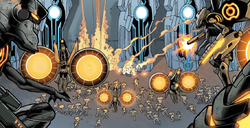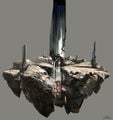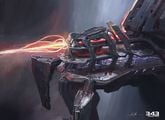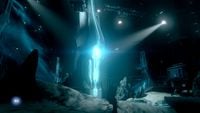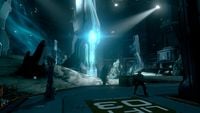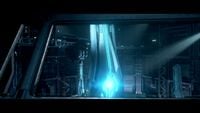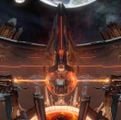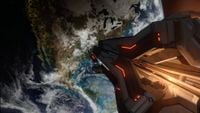Composer: Difference between revisions
From Halopedia, the Halo wiki
No edit summary |
No edit summary |
||
| Line 15: | Line 15: | ||
}} | }} | ||
The '''Composer'''<ref group="note">In ''Halo: Primordium'' and ''Halo 4'' | The '''Composer'''<ref group="note">In ''Halo: Primordium'' and ''Halo 4'' the Composer is consistently referenced as a singular entity, though ''Halo: Silentium'' establishes that there were actually multiple Composers; this is reflected in ''Halo: Escalation''. In light of this information it can be assumed that "the Composer" refers to the device as a unique invention as opposed to a single object, much as the Halos are sometimes referenced with the collective "Halo".</ref><ref name="h4evg">'''[[Halo 4: The Essential Visual Guide]]''', ''page 132''</ref> is a machine created by the [[Forerunner]]s to [[mind transfer|translate]] an organic being's mental content into machine data.<ref name="h4">'''Halo 4'''</ref> Categorized as a sublimation device,<ref name="h4evg"/> the Composer originated as one of the first of innumerable failed plans laid by the Forerunners to defeat the [[Flood]]. While its failure to save Flood victims quickly led to the machine being abandoned in this capacity, it was later used for a number of purposes beyond its original function.<ref name="string3">'''Halo: Silentium''', ''pages 40-41''</ref> | ||
==Function== | ==Function== | ||
===Overview=== | ===Overview=== | ||
[[File:Composer Face Melt.jpeg|left|thumb|150px|The effects of composition on [[Sandra Tillson|Dr. Sandra Tillson]]]] | [[File:Composer Face Melt.jpeg|left|thumb|150px|The effects of composition on [[Sandra Tillson|Dr. Sandra Tillson]]]] | ||
After | After a small portion of Forerunner society discovered the existence of the Flood parasite in the later stages of the [[human-Forerunner wars]], they quickly began to devise plans to combat the infection should it resurface. The Composers were one of the first solutions proposed by the [[Builder]]s. The original function of the machines was to save Flood victims by extracting their mental patterns (commonly known as essences) and translating them to data by broadcasting high-energy fields of entangled sympathies. The stored essence would then be imprinted on a new, artificially constructed biological body devoid of Flood infection. However, the process was highly flawed. In addition to being extremely painful to the individuals undergoing the process, all attempts to restore the essences to biological form failed as the artificial bodies would quickly decay and inevitably die.<ref name="string3"/> For this reason the Forerunners quickly abandoned the Composers after the first experiments.<ref name="pri271">'''Halo: Primordium''', ''pages 271-272''</ref><ref group="note">''[[Halo 4: The Essential Visual Guide]]'' describes the Composer's original function as granting the Forerunners immortality by transferring old essences into youthful bodies, implying that Forerunner medical science had not overcome senescence. According to ''[[Halo: Cryptum]]'' (page 47) along with a number of other references throughout ''The Forerunner Saga'', the Forerunners were functionally immortal given regular access to [[Forerunner personal armor|personal armor]], could remain youthful indefinitely, and died only by accident or in battle. The issue of Forerunner mortality by old age is also not brought up when the Composer's origins are described in ''[[Halo: Silentium]]''. In ''Halo 4'' the Librarian states that the Composer would have made the Forerunners immortal, although this may be interpreted as "true" immortality and invulnerability to the Flood, as opposed to the [[Wikipedia:Biological immortality|biological immortality]] the Forerunners already enjoyed thanks to their use of body-assist armor.</ref><ref name="whole" group="note">In ''[[Halo: Escalation Issue 9]]'', the monitor [[859 Static Carillon]] indicates that the human essences composed in New Phoenix are being "added to the whole" in accordance with the original design for the Composer, introducing fear, rage, and confusion. This implies that composed patterns are uploaded to a central intelligence, though whether this applies solely to the Promethean Knights or to all who who undergo composition is unclear. Nonetheless, the notion of composed essences being incorporated into a gestalt mind is not mentioned in prior media.</ref> | ||
The physical effects of the Composer on its targets | The physical effects of the Composer on its targets are also violent: the device projected a beam of orange light which completely reduces the targeted individuals to ash in a rather gruesome and painful manner. This is seemingly a byproduct of the machine's original design as a means to combat the Flood, allowing the complete destruction of infected biomass in a manner similar to certain Forerunner weapons designed to completely atomize their targets. The beam possesses the capability to process hundreds of thousands of targets in mere moments across enormous distances,<ref name="omega">'''Halo: Silentium''', ''page 263''</ref> such as composing targets on a planet's surface from an orbiting ship,<ref name="midnight">'''Halo 4''', campaign level ''[[Midnight]]''</ref> or those on the surface of an entire [[Halo Array|Halo]] [[Omega Halo|installation]] in an instant.<ref name="omega"/> [[Forthencho|Forthencho, Lord of Admirals]], the supreme commander of all human forces and one of the humans to have their minds harvested, described the effects of the Composer as "strange, ever-changing" and "multiformed", as it was operated in that instance via intermediary [[Lifeworker]] machinery.<ref name="p235">'''Halo: Primordium''', ''page 235''</ref> | ||
As witnessed on [[Installation 07]], Flood victims subjected to Composer processing were able to retain their | As witnessed on [[Installation 07]], Flood victims subjected to Composer processing were able to retain their individuality,<ref>'''Halo: Primordium''', ''pages 325-326''</ref> but the Flood would continue to rot and deform their physical bodies, the infection having survived the destruction of the original biological body and then resumed in the new one. The Forerunners attempted to slow down this process by wrapping the afflicted individuals' bodies in a form of supportive harness flowing with energy,<ref>'''Halo: Primordium''', ''pages 322-323''</ref> but the victims would still continue to deform beyond recognition and eventually expire or succumb to the Flood. Similarly, when the [[Gravemind]] used [[Logic plague#Biological beings|corrupted]], Composer-processed essences imprinted on living human bodies as messengers to the [[Librarian]] in her final moments on [[Earth]], the humans' bodies would rapidly decay and soon die.<ref>'''Halo: Silentium''', ''pages 320-323''</ref> | ||
===Essence preservation=== | ===Essence preservation=== | ||
| Line 33: | Line 33: | ||
===Immunization=== | ===Immunization=== | ||
The Composer | The Composer does not work on all organic beings; certain individuals can, through genetic manipulation, become immune to its effects. After undergoing an experimental [[Forerunner mutation|mutation]] in an attempt to gain immunity to the Flood, the Ur-Didact's physiology became incompatible with the Composer.<ref name="h4terminals">'''Halo 4''', ''[[Terminal/Halo 4|Terminals]]''</ref> Similarly, the ''[[geas]]'' the Librarian placed on humanity allowed [[SPARTAN-II program|Spartan]] [[John-117]] to develop a resistance to the Composer; this ability had to be activated and thus it does not automatically protect all humans from the device.<ref name="reclaimer">'''Halo 4''', campaign level ''[[Reclaimer (level)|Reclaimer]]''</ref> | ||
{{Clear}} | {{Clear}} | ||
==History== | ==History== | ||
===Creation and use at Charum Hakkor=== | ===Creation and use at Charum Hakkor=== | ||
Developed by the [[Builder]]s during the [[human-Forerunner wars]] as a countermeasure for the nascent [[Flood]], the Composers were constructed at a facility known as the [[Composer's Forge]]. | Developed by the [[Builder]]s during the [[human-Forerunner wars]] as a countermeasure for the nascent [[Flood]], the Composers were constructed at a facility known as the [[Composer's Forge]]. In the centuries following the conflict this installation would come to be overseen by a [[monitor]] known as [[859 Static Carillon]], who was regarded as the keeper of the Composers.<ref name="HE9"/> While the many faults of the Composers were quickly recognized, the Forerunners would later find other uses for the devices. | ||
After the [[Siege of Charum Hakkor|fifty-three-year siege]] of [[Charum Hakkor]], the strongly [[Builder]]-influenced [[Ecumene Council|Old Council]] intended to exact their vengeance on their [[prehistoric human civilization|human]] enemies and make sure the humans' fate would be as cruel as possible. Thus, even though the Forerunners already possessed other technologies capable of extracting an individual's memories and personality impressions,<ref>'''Halo: Cryptum''', ''pages 47-48, 138''</ref><ref name="sil57">'''Halo: Silentium''', ''page 57''</ref> the Council only | After the [[Siege of Charum Hakkor|fifty-three-year siege]] of [[Charum Hakkor]], the strongly [[Builder]]-influenced [[Ecumene Council|Old Council]] intended to exact their vengeance on their [[prehistoric human civilization|human]] enemies and make sure the humans' fate would be as cruel as possible. Thus, even though the Forerunners already possessed other technologies capable of extracting an individual's memories and personality impressions,<ref>'''Halo: Cryptum''', ''pages 47-48, 138''</ref><ref name="sil57">'''Halo: Silentium''', ''page 57''</ref> the Council provided only Composers to the [[Librarian]] and her [[Lifeworker]]s when they were ordered to process the last human survivors.<ref name="string3"/> The essences of the archived humans would be preserved in future generations of humans, with the intent that they would share their knowledge with the devolved remnants of humanity and aid them in rebuilding their civilization. The Master Builder and other like-minded Forerunners intended to study the stored memories in hopes of discovering how humanity managed to defeat the Flood, subjecting machine-stored copies of the essences to tortuous interrogation over thousands of years.<ref>'''Halo: Silentium''', ''pages 41-43''</ref> | ||
===Abandonment and later use=== | ===Abandonment and later use=== | ||
As a result of the risks and irregularities involved with their usage, the Forerunners eventually abandoned the Composers and their existence was made a closely guarded secret known to only a few.<ref name="pri271"/> Even the machines' actual nature remained obscure; whether the Composer was a machine or being remained uncertain to most. Some even believed the Composer to be a "product of its own services"; a Forerunner, perhaps a Lifeworker, suspended in the final stages of Flood infection.<ref name="p268">'''Halo: Primordium''', ''page 268''</ref><ref>'''Halo: Primordium''', ''page 278''</ref> | As a result of the risks and irregularities involved with their usage, the Forerunners eventually abandoned the Composers and their existence was made a closely guarded secret known to only a few.<ref name="pri271"/> Even the machines' actual nature remained obscure; whether the Composer was a machine or being remained uncertain to most. Some even believed the Composer to be a "product of its own services"; a Forerunner, perhaps a Lifeworker, suspended in the final stages of Flood infection.<ref name="p268">'''Halo: Primordium''', ''page 268''</ref><ref>'''Halo: Primordium''', ''page 278''</ref> | ||
Around [[100,000 BCE]] | Around [[100,000 BCE]] the Lifeworkers no longer employed the long-abandoned Composers when scanning sentient beings for indexing in the [[Conservation Measure]], instead using a far gentler form of [[mind transfer#Full pattern uploading|pattern extraction]] technology.<ref name="sil57"/> | ||
A Composer was acquired and used by [[Master Builder]] [[Faber]] in an attempt to stave off Flood infection in certain Forerunners on [[Installation 07]]. While in control of Installation 07, [[05-032 Mendicant Bias|Mendicant Bias]] and the [[Primordial]] also used the Composer to extract the ancestral memory imprints from [[Chakas]] and the other humans from [[Earth|Erde-Tyrene]].<ref name="p355"/> | A Composer was acquired and used by [[Master Builder]] [[Faber]] in an attempt to stave off Flood infection in certain Forerunners on [[Installation 07]]. While in control of Installation 07, [[05-032 Mendicant Bias|Mendicant Bias]] and the [[Primordial]] also used the Composer to extract the ancestral memory imprints from [[Chakas]] and the other humans from [[Earth|Erde-Tyrene]].<ref name="p355"/> | ||
Later during the war | Later during the war the [[Ur-Didact|Didact]] used the Composer to convert the [[Promethean]] warriors loyal to him into [[Promethean Knight|robotic forms]] to allow them to combat the Flood more efficiently and without risk of infection. To bolster his numbers the Didact used the Composer on a number of humans transplanted to [[Omega Halo]], turning them into additional forces in his mechanized army. This led to his imprisonment on [[Requiem]] by the [[Librarian]].<ref name="h4terminals"/> | ||
===Rediscovery=== | ===Rediscovery=== | ||
====Installation 03==== | ====Installation 03==== | ||
[[File:H4-ComposerFiringOnPhoenix.jpg|left|250px|thumb|The Composer firing on the city of [[New Phoenix]] on Earth]] | [[File:H4-ComposerFiringOnPhoenix.jpg|left|250px|thumb|The Composer firing on the city of [[New Phoenix]] on Earth]] | ||
One Composer was stored on Halo [[Installation 03]]. In late [[2554]] | One Composer was stored on Halo [[Installation 03]]. In late [[2554]]<ref>'''Halo 4''', campaign level ''[[Composer (level)|Composer]]'', [[Halo 4 audio logs|audio log]]''</ref> the [[United Nations Space Command|UNSC]] [[Office of Naval Intelligence]] discovered the machine, which they designated ''SBJ 8490-03'',<ref>'''[[Eleventh Hour reports]]''', ''Report 5/5''</ref> in a location known as the [[Composer's Abyss]]; after the flagship {{UNSCShip|Infinity}} extracted the device it was transported to [[Ivanoff Station]], a research facility in the asteroid field in Installation 03's orbit. The machine was partially buried within the installation's surface and remained embedded in a large chunk of rock when the ship transported it to Ivanoff. Some of the scientists were digitized by the Composer while studying it and the sensor data from the incident contained coordinates that led ''Infinity'' to [[Requiem]].<ref>'''Halo 4''', campaign level ''[[Infinity (level)|Infinity]]''</ref> | ||
Upon awakening on Requiem in [[2557#July|July 2557]], the Didact | Upon awakening on Requiem in [[2557#July|July 2557]], the Didact headed for the Composer at his first opportunity and acquired the device after [[Raid on Ivanoff Station|launching an attack]] on Ivanoff Station. Planning to use the Composer to neutralize all of mankind by forever imprisoning them in digital form, he first used it on the research and security personnel of Ivanoff; Spartan [[John-117]] was the only survivor as a result of genetic modifications imbued by the Librarian. The Didact then set course for Earth in order to realize the final stage of his plan. He successfully fired the Composer on a [[United Republic of North America|URNA]] metropolis, [[New Phoenix]], but the effect was halted when John-117 destroyed the Composer, and the Didact's ship along with it, with a [[HAVOK tactical nuclear weapon]].<ref name="midnight"/> Some of the resulting digital intelligences survived, having been transported into the Composer's Abyss on Installation 03<ref>'''Halo: Escalation''', ''Issue #8''</ref> and later to Requiem via a slipspace transit portal connected to the Composer.<ref name="memento"/> | ||
{{Clear}} | {{Clear}} | ||
====The Composer's Forge==== | ====The Composer's Forge==== | ||
[[File:Escalation - Composer's Forge Battle.png|thumb|250px|[[Blue Team]] and [[Promethean]]s battle in the [[Composer's Forge]].]] | [[File:Escalation - Composer's Forge Battle.png|thumb|250px|[[Blue Team]] and [[Promethean]]s battle in the [[Composer's Forge]].]] | ||
{{Main|Skirmish on Installation 03}} | {{Main|Skirmish on Installation 03}} | ||
Following the [[New Phoenix Incident]] | Following the [[New Phoenix Incident]] the Didact was plunged to [[Installation 03]] through the Composer's slipspace portal. After killing a team of human scientists and their [[Black Team|Spartan escorts]], the Didact wished to seek revenge on Earth. Soon he encountered [[monitor]] [[859 Static Carillon]] at the [[Composer's Abyss]]. Recognizing the monitor as the keeper of the Composers, the Didact had Static Carillon show him [[slipspace portal|the entrance]] to the [[Composer's Forge]], where the Composers were constructed and maintained. Shortly after, [[Blue Team]] discovered the slipspace portal that led to the Forge. Upon entering the Spartans were shocked to discover six more Composers located inside the Forge. The Spartans were confronted by the Didact and a large firefight ensued, with numerous [[Promethean]] constructs backing up the Didact. Static Carillon had a Halo installation appear over the Composer's Forge per his agreement with the Didact, who then took one of the six Composers and departed the Forge for the Halo. Static Carillon revealed to the Spartans that the Didact intended to use the Composer and the Halo to destroy humanity, starting with Earth. With the monitor's help Blue Team escaped the Composer's Forge and returned to Installation 03 through the Composer's Abyss. Upon exiting the Abyss Blue Team witnessed the Didact positioning the Composer over the Halo. Intending to remove Blue Team as a threat the Didact attacked the Spartans.<ref name="HE9"/><ref name="whole" group="note"/> | ||
{{Clear}} | {{Clear}} | ||
Revision as of 17:39, August 31, 2014
- "The Composer! So many possibilities and capabilities tied up in that strange name... A Composer of minds and souls!"
- — Forthencho, Lord of Admirals[1]
The Composer[note 1][2] is a machine created by the Forerunners to translate an organic being's mental content into machine data.[3] Categorized as a sublimation device,[2] the Composer originated as one of the first of innumerable failed plans laid by the Forerunners to defeat the Flood. While its failure to save Flood victims quickly led to the machine being abandoned in this capacity, it was later used for a number of purposes beyond its original function.[4]
Function
Overview
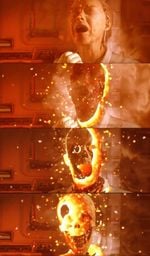
After a small portion of Forerunner society discovered the existence of the Flood parasite in the later stages of the human-Forerunner wars, they quickly began to devise plans to combat the infection should it resurface. The Composers were one of the first solutions proposed by the Builders. The original function of the machines was to save Flood victims by extracting their mental patterns (commonly known as essences) and translating them to data by broadcasting high-energy fields of entangled sympathies. The stored essence would then be imprinted on a new, artificially constructed biological body devoid of Flood infection. However, the process was highly flawed. In addition to being extremely painful to the individuals undergoing the process, all attempts to restore the essences to biological form failed as the artificial bodies would quickly decay and inevitably die.[4] For this reason the Forerunners quickly abandoned the Composers after the first experiments.[5][note 2][note 3]
The physical effects of the Composer on its targets are also violent: the device projected a beam of orange light which completely reduces the targeted individuals to ash in a rather gruesome and painful manner. This is seemingly a byproduct of the machine's original design as a means to combat the Flood, allowing the complete destruction of infected biomass in a manner similar to certain Forerunner weapons designed to completely atomize their targets. The beam possesses the capability to process hundreds of thousands of targets in mere moments across enormous distances,[6] such as composing targets on a planet's surface from an orbiting ship,[7] or those on the surface of an entire Halo installation in an instant.[6] Forthencho, Lord of Admirals, the supreme commander of all human forces and one of the humans to have their minds harvested, described the effects of the Composer as "strange, ever-changing" and "multiformed", as it was operated in that instance via intermediary Lifeworker machinery.[8]
As witnessed on Installation 07, Flood victims subjected to Composer processing were able to retain their individuality,[9] but the Flood would continue to rot and deform their physical bodies, the infection having survived the destruction of the original biological body and then resumed in the new one. The Forerunners attempted to slow down this process by wrapping the afflicted individuals' bodies in a form of supportive harness flowing with energy,[10] but the victims would still continue to deform beyond recognition and eventually expire or succumb to the Flood. Similarly, when the Gravemind used corrupted, Composer-processed essences imprinted on living human bodies as messengers to the Librarian in her final moments on Earth, the humans' bodies would rapidly decay and soon die.[11]
Essence preservation

Minds scanned by the Composer could be processed in a variety of ways. The ancient human personalities extracted and stored by the Librarian at Charum Hakkor retained their essences in virtually unchanged form, preserving the victims' identities and even the records of their physical bodies, although the latter could not be reconstituted to biological form.[12] These stored personalities could also be implanted into the genetic code of living beings, with said personalities achieving self-awareness and retaining their original identity within their new hosts; an example of this are the ancestral memory imprints of Chakas and Riser. The Composer could also be used to remove these imprinted personalities, although this did grave physical and mental damage to the individual carrying the imprint.[13]
In the case of the Ur-Didact's Promethean Knights, the extracted neural map was used as the basis for artificial intelligence constructs in a manner similar to the creation of human smart AIs. These intelligences contain many of their original memories and sometimes even portions of their personality, but otherwise behave within the limits of the duties assigned to them.[14] These essences were stored in imprint matrices known as Durances, similar to the devices traditionally used to contain the last mental impressions of a deceased Forerunner.[15]
Immunization
The Composer does not work on all organic beings; certain individuals can, through genetic manipulation, become immune to its effects. After undergoing an experimental mutation in an attempt to gain immunity to the Flood, the Ur-Didact's physiology became incompatible with the Composer.[16] Similarly, the geas the Librarian placed on humanity allowed Spartan John-117 to develop a resistance to the Composer; this ability had to be activated and thus it does not automatically protect all humans from the device.[17]
History
Creation and use at Charum Hakkor
Developed by the Builders during the human-Forerunner wars as a countermeasure for the nascent Flood, the Composers were constructed at a facility known as the Composer's Forge. In the centuries following the conflict this installation would come to be overseen by a monitor known as 859 Static Carillon, who was regarded as the keeper of the Composers.[18] While the many faults of the Composers were quickly recognized, the Forerunners would later find other uses for the devices.
After the fifty-three-year siege of Charum Hakkor, the strongly Builder-influenced Old Council intended to exact their vengeance on their human enemies and make sure the humans' fate would be as cruel as possible. Thus, even though the Forerunners already possessed other technologies capable of extracting an individual's memories and personality impressions,[19][20] the Council provided only Composers to the Librarian and her Lifeworkers when they were ordered to process the last human survivors.[4] The essences of the archived humans would be preserved in future generations of humans, with the intent that they would share their knowledge with the devolved remnants of humanity and aid them in rebuilding their civilization. The Master Builder and other like-minded Forerunners intended to study the stored memories in hopes of discovering how humanity managed to defeat the Flood, subjecting machine-stored copies of the essences to tortuous interrogation over thousands of years.[21]
Abandonment and later use
As a result of the risks and irregularities involved with their usage, the Forerunners eventually abandoned the Composers and their existence was made a closely guarded secret known to only a few.[5] Even the machines' actual nature remained obscure; whether the Composer was a machine or being remained uncertain to most. Some even believed the Composer to be a "product of its own services"; a Forerunner, perhaps a Lifeworker, suspended in the final stages of Flood infection.[22][23]
Around 100,000 BCE the Lifeworkers no longer employed the long-abandoned Composers when scanning sentient beings for indexing in the Conservation Measure, instead using a far gentler form of pattern extraction technology.[20]
A Composer was acquired and used by Master Builder Faber in an attempt to stave off Flood infection in certain Forerunners on Installation 07. While in control of Installation 07, Mendicant Bias and the Primordial also used the Composer to extract the ancestral memory imprints from Chakas and the other humans from Erde-Tyrene.[13]
Later during the war the Didact used the Composer to convert the Promethean warriors loyal to him into robotic forms to allow them to combat the Flood more efficiently and without risk of infection. To bolster his numbers the Didact used the Composer on a number of humans transplanted to Omega Halo, turning them into additional forces in his mechanized army. This led to his imprisonment on Requiem by the Librarian.[16]
Rediscovery
Installation 03
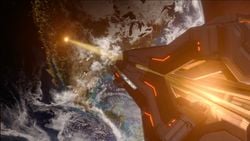
One Composer was stored on Halo Installation 03. In late 2554[24] the UNSC Office of Naval Intelligence discovered the machine, which they designated SBJ 8490-03,[25] in a location known as the Composer's Abyss; after the flagship UNSC Infinity extracted the device it was transported to Ivanoff Station, a research facility in the asteroid field in Installation 03's orbit. The machine was partially buried within the installation's surface and remained embedded in a large chunk of rock when the ship transported it to Ivanoff. Some of the scientists were digitized by the Composer while studying it and the sensor data from the incident contained coordinates that led Infinity to Requiem.[26]
Upon awakening on Requiem in July 2557, the Didact headed for the Composer at his first opportunity and acquired the device after launching an attack on Ivanoff Station. Planning to use the Composer to neutralize all of mankind by forever imprisoning them in digital form, he first used it on the research and security personnel of Ivanoff; Spartan John-117 was the only survivor as a result of genetic modifications imbued by the Librarian. The Didact then set course for Earth in order to realize the final stage of his plan. He successfully fired the Composer on a URNA metropolis, New Phoenix, but the effect was halted when John-117 destroyed the Composer, and the Didact's ship along with it, with a HAVOK tactical nuclear weapon.[7] Some of the resulting digital intelligences survived, having been transported into the Composer's Abyss on Installation 03[27] and later to Requiem via a slipspace transit portal connected to the Composer.[14]
The Composer's Forge
- Main article: Skirmish on Installation 03
Following the New Phoenix Incident the Didact was plunged to Installation 03 through the Composer's slipspace portal. After killing a team of human scientists and their Spartan escorts, the Didact wished to seek revenge on Earth. Soon he encountered monitor 859 Static Carillon at the Composer's Abyss. Recognizing the monitor as the keeper of the Composers, the Didact had Static Carillon show him the entrance to the Composer's Forge, where the Composers were constructed and maintained. Shortly after, Blue Team discovered the slipspace portal that led to the Forge. Upon entering the Spartans were shocked to discover six more Composers located inside the Forge. The Spartans were confronted by the Didact and a large firefight ensued, with numerous Promethean constructs backing up the Didact. Static Carillon had a Halo installation appear over the Composer's Forge per his agreement with the Didact, who then took one of the six Composers and departed the Forge for the Halo. Static Carillon revealed to the Spartans that the Didact intended to use the Composer and the Halo to destroy humanity, starting with Earth. With the monitor's help Blue Team escaped the Composer's Forge and returned to Installation 03 through the Composer's Abyss. Upon exiting the Abyss Blue Team witnessed the Didact positioning the Composer over the Halo. Intending to remove Blue Team as a threat the Didact attacked the Spartans.[18][note 3]
Gallery
Concept art of one of the shield generators around the Composer on the level Midnight
Gabriel Thorne's nightmare of New Phoenix's population being composed
List of appearances
- Halo: Primordium (First appearance)
- Halo 4
- Halo: Silentium
- Halo: Escalation
Notes
- ^ In Halo: Primordium and Halo 4 the Composer is consistently referenced as a singular entity, though Halo: Silentium establishes that there were actually multiple Composers; this is reflected in Halo: Escalation. In light of this information it can be assumed that "the Composer" refers to the device as a unique invention as opposed to a single object, much as the Halos are sometimes referenced with the collective "Halo".
- ^ Halo 4: The Essential Visual Guide describes the Composer's original function as granting the Forerunners immortality by transferring old essences into youthful bodies, implying that Forerunner medical science had not overcome senescence. According to Halo: Cryptum (page 47) along with a number of other references throughout The Forerunner Saga, the Forerunners were functionally immortal given regular access to personal armor, could remain youthful indefinitely, and died only by accident or in battle. The issue of Forerunner mortality by old age is also not brought up when the Composer's origins are described in Halo: Silentium. In Halo 4 the Librarian states that the Composer would have made the Forerunners immortal, although this may be interpreted as "true" immortality and invulnerability to the Flood, as opposed to the biological immortality the Forerunners already enjoyed thanks to their use of body-assist armor.
- ^ a b In Halo: Escalation Issue 9, the monitor 859 Static Carillon indicates that the human essences composed in New Phoenix are being "added to the whole" in accordance with the original design for the Composer, introducing fear, rage, and confusion. This implies that composed patterns are uploaded to a central intelligence, though whether this applies solely to the Promethean Knights or to all who who undergo composition is unclear. Nonetheless, the notion of composed essences being incorporated into a gestalt mind is not mentioned in prior media.
Sources
- ^ Halo: Primordium, page 232-233
- ^ a b Halo 4: The Essential Visual Guide, page 132
- ^ Halo 4
- ^ a b c Halo: Silentium, pages 40-41
- ^ a b Halo: Primordium, pages 271-272
- ^ a b Halo: Silentium, page 263
- ^ a b Halo 4, campaign level Midnight
- ^ Halo: Primordium, page 235
- ^ Halo: Primordium, pages 325-326
- ^ Halo: Primordium, pages 322-323
- ^ Halo: Silentium, pages 320-323
- ^ Halo: Silentium, page 320
- ^ a b Halo: Primordium, page 355
- ^ a b Spartan Ops, S1E5 Memento Mori
- ^ Halo 4: The Essential Visual Guide, page 134
- ^ a b Halo 4, Terminals
- ^ Halo 4, campaign level Reclaimer
- ^ a b Cite error: Invalid
<ref>tag; no text was provided for refs namedHE9 - ^ Halo: Cryptum, pages 47-48, 138
- ^ a b Halo: Silentium, page 57
- ^ Halo: Silentium, pages 41-43
- ^ Halo: Primordium, page 268
- ^ Halo: Primordium, page 278
- ^ Halo 4, campaign level Composer, audio log
- ^ Eleventh Hour reports, Report 5/5
- ^ Halo 4, campaign level Infinity
- ^ Halo: Escalation, Issue #8
| ||||||||
